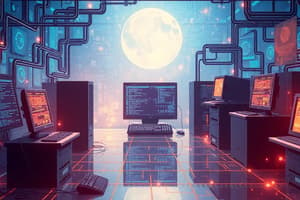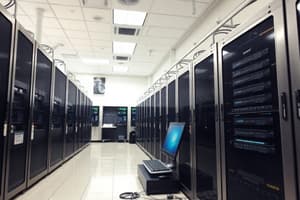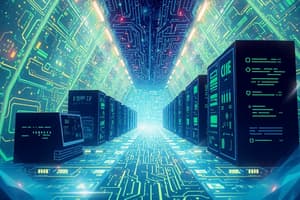Podcast
Questions and Answers
What is the primary distinction between data and information?
What is the primary distinction between data and information?
- Data is unprocessed raw facts, while information is processed data that has meaning. (correct)
- Data is always in numerical form, while information can be numerical or textual.
- Data is a type of software, while information refers to hardware components.
- Data can only be numbers, while information can only be symbols.
Which characteristic is NOT true of a computer?
Which characteristic is NOT true of a computer?
- It is electronic.
- It can function without any powered input. (correct)
- It can manipulate data.
- It has memory.
Which capability of computers focuses on storing and recalling data?
Which capability of computers focuses on storing and recalling data?
- Self-directing
- Self-checking
- Stores/recalls data (correct)
- Speed
What limitation does a computer have when executing instructions?
What limitation does a computer have when executing instructions?
Which type of computer is designed for high-performance single-user tasks?
Which type of computer is designed for high-performance single-user tasks?
What is NOT an application of computers?
What is NOT an application of computers?
Which of the following is a defining feature of a supercomputer?
Which of the following is a defining feature of a supercomputer?
What device could be included in a computer system?
What device could be included in a computer system?
What significant contribution did George Boole make?
What significant contribution did George Boole make?
Which invention is associated with Lee De Forest?
Which invention is associated with Lee De Forest?
What was the primary purpose of the ENIAC machine?
What was the primary purpose of the ENIAC machine?
Who developed the UNIVAC I compiler?
Who developed the UNIVAC I compiler?
What characteristic distinguished the Z3 computer introduced by Konrad Zuse?
What characteristic distinguished the Z3 computer introduced by Konrad Zuse?
What was the primary limitation of the ENIAC regarding its programmability?
What was the primary limitation of the ENIAC regarding its programmability?
What significant technological advancement occurred in the 1950s in relation to vacuum tubes?
What significant technological advancement occurred in the 1950s in relation to vacuum tubes?
Who were the inventors of the transistor?
Who were the inventors of the transistor?
Who were the pioneers behind the first commercially sold computer?
Who were the pioneers behind the first commercially sold computer?
What significant advancement in computing occurred in 1958?
What significant advancement in computing occurred in 1958?
Which programming language was developed in 1965 for beginners?
Which programming language was developed in 1965 for beginners?
When was the first handheld calculator design completed by Texas Instruments?
When was the first handheld calculator design completed by Texas Instruments?
What was a major capability of the ATM introduced in the late 1960s?
What was a major capability of the ATM introduced in the late 1960s?
Which device was marketed three years after its design was completed in 1967?
Which device was marketed three years after its design was completed in 1967?
What was the primary purpose of ARPANET established in 1969?
What was the primary purpose of ARPANET established in 1969?
In what year did Jack St.Clair Kilby and Robert Noyce win the Nobel Prize for Physics?
In what year did Jack St.Clair Kilby and Robert Noyce win the Nobel Prize for Physics?
What was significant about the release of the Intel 4004 microprocessor in 1971?
What was significant about the release of the Intel 4004 microprocessor in 1971?
Who invented the first microprocessor?
Who invented the first microprocessor?
Which programming language was developed by Niklaus Wirth in 1971?
Which programming language was developed by Niklaus Wirth in 1971?
What innovation occurred in 1972 at a grocery store in Cincinnati, Ohio?
What innovation occurred in 1972 at a grocery store in Cincinnati, Ohio?
Which company created the first commercially successful coin-operated video game?
Which company created the first commercially successful coin-operated video game?
What was the first scientific handheld calculator introduced by Hewlett-Packard?
What was the first scientific handheld calculator introduced by Hewlett-Packard?
What role did William Gates and Paul Allen play in the founding of Microsoft?
What role did William Gates and Paul Allen play in the founding of Microsoft?
What was the processing capability of the Intel 4004 microprocessor?
What was the processing capability of the Intel 4004 microprocessor?
What significant event occurred in 1983 concerning the ARPANET?
What significant event occurred in 1983 concerning the ARPANET?
Who were the designers of the TCP/IP protocol?
Who were the designers of the TCP/IP protocol?
Which computer was first introduced in 1977 and became popular shortly after its release?
Which computer was first introduced in 1977 and became popular shortly after its release?
What was the significance of the first digital audio CD discs made available in 1982?
What was the significance of the first digital audio CD discs made available in 1982?
What unique recognition did Time magazine give to computers in 1982?
What unique recognition did Time magazine give to computers in 1982?
Which software program was first sold for the Apple II in 1979?
Which software program was first sold for the Apple II in 1979?
Which computer company offered Bill Gates the chance to develop an operating system in 1980?
Which computer company offered Bill Gates the chance to develop an operating system in 1980?
What did the MIDI standard established in 1982 allow?
What did the MIDI standard established in 1982 allow?
Flashcards are hidden until you start studying
Study Notes
Data vs. Information
- Data consists of raw facts, including numbers and symbols.
- Information is processed data that has meaning and context.
- Computers excel at converting data into useful information through processing.
Characteristics of Computers
- Computers are machines that operate electronically.
- Capable of manipulating data automatically.
- Equipped with memory for data storage.
- Perform logical functions based on programmed commands.
Capabilities of Computers
- Self-directing operations for automated tasks.
- Ability to store and recall significant amounts of data.
- Conduct self-checks for accuracy and integrity.
- Execute logical functions rapidly and efficiently.
Limitations of Computers
- Operate solely on pre-designed program instructions.
- Cannot correct erroneous instructions or data autonomously.
- Applications need to be quantifiable for computer processing.
- Errors can occur despite built-in checks.
Computer System
- A computer system includes interconnected hardware components such as processors, storage devices, and input/output devices.
Categories of Computers
- Personal Computer (PC): Designed for individual use, typically small and accessible.
- Workstation: High-performance, single-user systems with advanced input/output capabilities suitable for networking.
- Mainframe Computer: Large systems serving multiple users simultaneously, supporting enterprise-wide applications.
- Supercomputer: Represents the most powerful computers, designed for intensive computations.
Applications of Computers
- Information systems for data management.
- Personal computing for everyday tasks.
- Communication across various media.
- Scientific research and engineering applications.
- Educational tools and resources.
- Entertainment, including gaming and multimedia experiences.
Brief Timeline in the History of Computers
- 1850s: Abacus introduced as the first counting mechanism.
- 1906: Invention of the vacuum tube, serving as early memory technology.
- 1939: First electronic digital computer constructed by Atanasoff and Berry.
- 1941: Z3, the first programmable computer, created by Konrad Zuse.
- 1947: ENIAC introduced, using 18,000 vacuum tubes for complex calculations.
- 1951: UNIVAC I, first commercially available computer for business applications, developed.
- 1958: First integrated circuit produced, allowing miniaturization of components.
- 1965: Development of the BASIC programming language.
- 1971: Introduction of the first microprocessor (Intel 4004) revolutionizes computer design.
- 1980-1983: IBM's PC launched with MS-DOS, and the Internet's foundation established with TCP/IP protocol.
Key Innovations and Events
- The invention of the transistor in 1947 fundamentally changed computer architecture.
- The rise of programming languages facilitated flexible coding and software development.
- The introduction of personal computers in the 1970s democratized access to computing power.
- The birth of the Internet transformed global communication and data exchange.
Studying That Suits You
Use AI to generate personalized quizzes and flashcards to suit your learning preferences.




